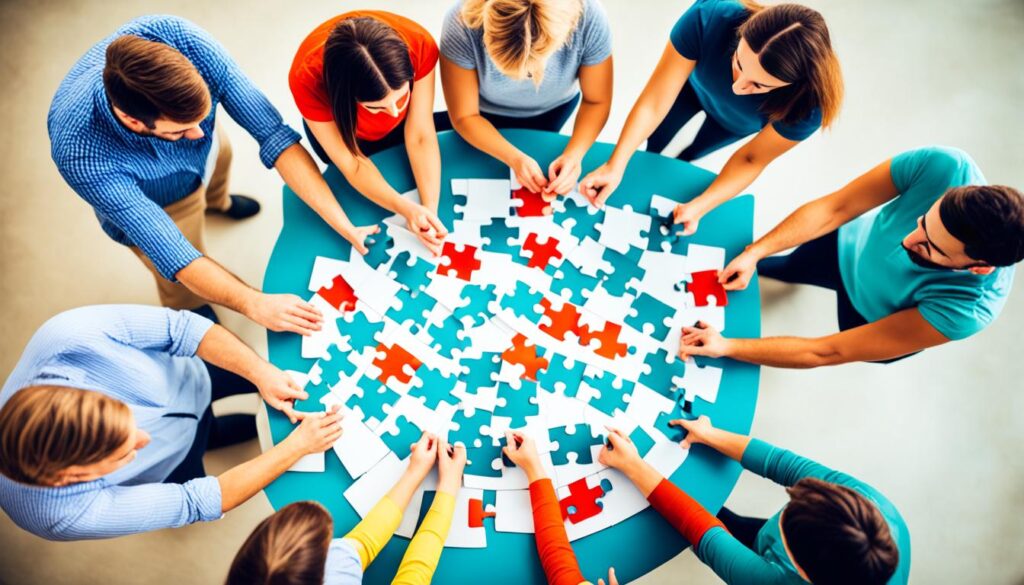Are you struggling to find time for team building activities in your busy work schedule? Do you believe that team building requires hours of investment? Think again! In just 5 minutes, you can energize your team, build camaraderie, and promote effective collaboration. Discover the power of quick team building activities that bring fun and unity to your workplace.
Key Takeaways:
- 5-minute team building activities are perfect for time-strapped SMEs.
- These quick activities boost team morale and productivity.
- Enhance communication and promote effective collaboration in just a few minutes.
- Quick icebreakers and skill-building exercises engage teams instantly.
- Adapt team building activities for both remote and in-office teams.
The Importance of Brief Team Building Exercises for SMEs
Team building exercises are not just a fun activity, but they also have significant benefits for small and medium-sized enterprises (SMEs). These brief team building exercises play a crucial role in boosting team morale and productivity.
Boosting Team Morale and Productivity
Engaging in team building activities helps team members develop a sense of unity and camaraderie. By working together on these exercises, team members build stronger connections and improve their overall job satisfaction. This sense of unity and positive team morale translates into higher productivity levels, as employees feel motivated and supported in their work.
Team morale and productivity are essential for the success of any SME. When team members feel connected and valued, they are more likely to be engaged and dedicated to their work. By incorporating brief team building exercises into the work routine, SMEs can cultivate a positive and productive work environment.
Encouraging Efficiency During Work Hours
In addition to boosting team morale, brief team building exercises also encourage efficiency during work hours. These activities improve communication among team members, fostering better collaboration and cooperation. By engaging in problem-solving exercises and interactive challenges, team members develop essential skills that enable them to work more efficiently as a team.
Efficient work hours are crucial for SMEs that need to make the most of their resources. Through team building activities, SMEs can enhance team unity, collaboration, and problem-solving skills, all of which contribute to a more streamlined and effective work process. By creating a work environment that values teamwork and collaboration, SMEs can achieve their goals more efficiently.
Image:
| Benefits of Brief Team Building Exercises for SMEs |
|---|
| Boosts team morale |
| Improves team productivity |
| Enhances communication |
| Fosters collaboration |
| Develops problem-solving skills |
5 Minute Team Building Activities for Enhanced Communication
Effective communication is the foundation of a successful team. In order to improve team communication and enhance overall collaboration, it is important to engage in targeted team building activities. These activities are specifically designed to strengthen communication skills, foster open and transparent channels of communication, and promote better understanding among team members.
One such activity is the “Active Listening Exercise.” In this exercise, team members pair up and take turns speaking while their partner actively listens without interruption. The active listener then summarizes what they heard and provides feedback. This exercise not only improves active listening skills but also encourages empathy and understanding.
Another effective activity is the “Non-Verbal Communication Challenge.” In this activity, team members communicate with each other using only non-verbal cues such as gestures, facial expressions, and body language. This exercise helps team members become more aware of the impact of their non-verbal communication and fosters stronger non-verbal communication skills.
Additionally, the “Open Communication Circle” activity promotes open and transparent communication within the team. In this activity, team members sit in a circle and take turns sharing their thoughts, ideas, and concerns. This encourages everyone to actively participate and ensures that everyone has an equal opportunity to contribute to the conversation.
By engaging in these 5-minute team building activities, teams can enhance their communication skills, develop stronger relationships, and improve overall teamwork. Effective communication leads to better collaboration, increased productivity, and a positive team environment.

| Activity | Description |
|---|---|
| Active Listening Exercise | Pair up team members and practice active listening skills by summarizing and providing feedback on what was heard. |
| Non-Verbal Communication Challenge | Communicate with team members using only non-verbal cues such as gestures, facial expressions, and body language. |
| Open Communication Circle | Sit in a circle and take turns sharing thoughts, ideas, and concerns to foster open and transparent communication. |
Innovative Icebreakers for Instant Team Engagement
Icebreakers are essential for creating a positive and inclusive team environment. They help team members get to know each other, build trust, and break down barriers. In this section, we will discuss how to choose the right icebreaker for your team and provide a list of top quick icebreaker ideas. These innovative icebreakers will instantly engage your team and set the stage for productive collaboration and teamwork.
How to Choose the Right Icebreaker
When choosing an icebreaker activity for your team, it’s important to consider the goals and dynamics of your team. Here are some factors to keep in mind:
- Team size: Consider the number of participants and choose activities that can easily accommodate your team.
- Time constraints: Select icebreakers that can be completed within a short period, such as 5 or 10 minutes.
- Team preferences: Take into account the interests and preferences of your team members to ensure they enjoy and engage in the activity.
Top Quick Icebreaker Ideas for Teams
Now that you know how to choose the right icebreaker, here are some quick and fun icebreaker ideas to get your team engaged:
- Two Truths and a Lie: Have each team member share two true statements and one false statement about themselves. The rest of the team must guess which statement is the lie.
- Human Knot: Have your team stand in a circle and hold hands with two different people across the circle. The challenge is to untangle the “knot” without letting go of each other’s hands.
- Emoji Challenge: Assign different emotions to team members and have them act out the emotion using only emojis. The rest of the team must guess the emotion.
- Photo Share: Ask each team member to share a photo from their phone and explain why it is meaningful to them. This activity helps team members get to know each other on a more personal level.
These icebreaker activities will help your team bond, build connections, and create a positive team culture. Remember to choose the activities that align with your team’s goals and have fun while engaging your team!
Creative Challenges for Team Skill-Building
Team building activities provide valuable opportunities for skill-building and professional development. Beyond fostering unity and collaboration, these activities can focus on developing specific skills within teams. By engaging in creative challenges, team members can enhance their abilities while enjoying a fun and interactive experience.
Short Skill-Based Activities for Groups
To improve team skills, incorporating short skill-based activities is crucial. These activities are designed to promote learning, problem-solving, and collaboration in a time-efficient manner. By allocating just a few minutes to these exercises, teams can address specific skills and enhance their overall performance.
“Coming together is a beginning. Keeping together is progress. Working together is success.” – Henry Ford
Below are some examples of short skill-based activities that are effective for group skill-building:
- Role-playing exercises: Encourage teams to act out different scenarios that require effective communication and problem-solving skills.
- Team quizzes: Engage teams in a friendly competition by organizing quizzes that test their knowledge on industry-related topics or company-specific information.
- Puzzles and brain teasers: Provide teams with challenging puzzles or brain teasers to promote critical thinking, creativity, and problem-solving abilities.
- Design challenges: Assign teams with design challenges that require them to brainstorm, collaborate, and innovate to develop creative solutions.
Keys to Effective Skill Enhancement Games
To ensure skill enhancement games have a lasting impact, certain factors should be considered:
- Clear objectives: Clearly define the objectives of the skill enhancement game, ensuring that they align with the desired skill development.
- Feedback mechanisms: Incorporate feedback mechanisms throughout the game to provide team members with insights on their performance and areas for improvement.
- Opportunities for reflection and growth: Encourage team members to reflect on their experiences, discuss lessons learned, and identify strategies for skill enhancement and personal growth.

By implementing creative challenges and skill-building activities, teams can continuously develop their abilities, strengthen collaboration, and achieve higher levels of success.
Simple Group Activities that Foster Teamwork
Teamwork is crucial for the success of any organization. When team members collaborate effectively, they can achieve shared goals, solve problems efficiently, and create a positive work environment. To foster teamwork and encourage collaboration among team members, there are many simple group activities that you can implement. These activities are easy to organize and require minimal resources, making them perfect for small and medium-sized enterprises (SMEs) in the Philippines.
One effective team bonding exercise is the “Minefield” activity. In this exercise, participants are divided into pairs, with one person blindfolded. The blindfolded person must navigate through an obstacle course while their partner gives them verbal instructions. This activity promotes trust, effective communication, and problem-solving skills.
Another activity that fosters teamwork is the “Human Knot.” In this activity, participants stand in a circle and randomly hold hands with two people across from them. The goal is for the group to untangle themselves without letting go of each other’s hands. This activity requires teamwork, coordination, and clear communication.
The success of a team lies in its ability to work together, communicate effectively, and overcome challenges. Simple group activities provide an opportunity for team members to develop trust, improve their communication skills, and strengthen their overall teamwork abilities.
A collaborative activity that encourages teamwork is the “Puzzle Challenge.” In this activity, team members are provided with a puzzle and must work together to solve it within a given time frame. This exercise promotes problem-solving, critical thinking, and collaboration.
Lastly, the “Minefield Race” activity is a fun and engaging team building exercise. Teams must navigate through a designated area filled with obstacles, without touching any of them. This activity requires effective communication, planning, and teamwork to successfully complete the race.
By engaging in these simple group activities, teams can develop trust, improve communication, and strengthen their overall teamwork skills. These activities provide an opportunity for team members to work together, solve problems, and collaborate effectively. Incorporating these activities into your team building efforts can contribute to increased team cohesion and productivity.
Selecting 5 Minute Team Building Activities for Your Goals
When it comes to team building, selecting activities that align with your team’s goals and dynamics is key to maximizing their impact. In this section, we will explore how to identify your team building objectives and provide guidance on selecting the most suitable activities based on your team’s unique dynamics.

Identifying Your Team Building Objectives
To effectively select team building activities, it’s essential to first identify your team’s specific objectives. Consider the following questions:
- What skills or qualities do you want to develop within your team?
- What challenges or issues does your team currently face?
- Are there any specific goals or outcomes you want to achieve through team building?
By clearly defining your objectives, you can narrow down the types of activities that will best support your team’s growth and development.
Activity Selection Based on Team Dynamics
Every team is unique, with its own dynamics and working styles. When selecting team building activities, it’s crucial to consider these factors to ensure maximum engagement and effectiveness. Take into account:
- The size of your team: Some activities may work better for larger groups, while others may be more suitable for smaller teams.
- The nature of your work: Consider the specific industry or field your team operates in and choose activities that align with the work context.
- The team’s communication style: If your team prefers more structured or informal communication, select activities that cater to their preferences.
By tailoring team building activities to your team’s unique dynamics, you can create a more cohesive and effective team, fostering a positive and collaborative work environment.
Examples of Tailored Team Building Activities
| Team Building Objective | Team Dynamics | Suggested Activities |
|---|---|---|
| Enhancing Communication | Diverse communication styles | Role-playing exercises, open-ended discussions |
| Fostering Collaboration | Remote team members | Virtual escape rooms, online collaboration tools |
| Improving Problem-solving Skills | Analytical thinkers | Escape room challenges, logic puzzles |
| Building Trust | Newly formed teams | Trust-building exercises, team bonding activities |
Use this table as a starting point to select team building activities that align with your team’s objectives and dynamics.
Fostering Collaboration with Quick Team Building Games
Collaboration is essential for effective teamwork and achieving goals. One of the most engaging ways to foster collaboration within a team is through quick team building games. These games provide an interactive and fun platform for team members to work together, communicate, and problem-solve. By engaging in these activities, teams can strengthen their bond, enhance teamwork skills, and improve overall performance.
Games Perfect for Enhancing Teamwork
There are numerous team building games that are perfect for enhancing teamwork and collaboration. Here are a few examples:
- The Human Knot: In this game, team members stand in a circle and join hands with two people across from them. The goal is to untangle themselves without letting go of each other’s hands. This game requires strong communication and collaboration to successfully unravel the human knot.
- Escape Room Challenge: Virtual or physical escape rooms are excellent team building games that require teams to work together to solve puzzles and find clues to escape the room within a set time limit. These challenges promote critical thinking, problem-solving, and effective communication among team members.
- Blindfold Drawing: This game involves pairing team members, where one person wears a blindfold and the other guides them to draw a specific object without using words. This activity fosters trust, clear communication, and effective collaboration between team members.
These games not only provide an opportunity for team members to collaborate but also offer a fun and enjoyable experience that strengthens team dynamics.
Implementing Games Without Disrupting Workflow
While team building games are important, it’s crucial to implement them without disrupting workflow. Here are some tips to seamlessly integrate team building games into the workday:
- Schedule dedicated time: Set aside specific times during the week or month for team building activities. This ensures that team members are prepared and can fully engage without feeling overwhelmed with work responsibilities.
- Keep it brief: Choose quick team building games that can be completed within a short time frame, such as 15 minutes. This allows for regular engagement without causing significant disruptions to work schedules.
- Align with goals: Select team building games that align with the goals and objectives of the team. This helps to ensure that the activities have a tangible impact on teamwork and collaboration while promoting skill development.
- Encourage participation: Create a positive and inclusive environment where team members feel comfortable participating in team building games. Encouraging active involvement and recognizing contributions can boost morale and enhance the overall effectiveness of the activities.
By implementing these games strategically and thoughtfully, teams can enjoy the benefits of enhanced collaboration and teamwork without compromising productivity.
Rapid Team Building Activities to Start the Day Positively
Starting the day on a positive note can set the tone for the rest of the day. In this section, we will discuss rapid team building activities specifically designed to start the day positively. These quick exercises will energize and inspire your team, fostering a positive and motivated work environment right from the beginning.
One of the ways to kickstart your team’s morning is by incorporating energizing morning team building exercises. These activities are designed to get your team members moving, interacting, and building connections early in the day.
One popular activity is a quick round of “Two Truths and a Lie.” Each team member shares two true statements and one false statement about themselves. The rest of the team tries to guess which statement is the lie. This activity not only helps team members get to know each other better but also injects a sense of fun and excitement into the morning routine.
Another activity to consider is a “Morning Huddle.” Gather your team in a circle, and give each team member a few minutes to share something positive or inspiring that happened to them recently. Encourage team members to express gratitude, share their accomplishments, or highlight a positive moment. This activity fosters a sense of positivity and sets a cooperative tone for the rest of the day.

In addition to these specific activities, it’s essential to create a positive and inclusive atmosphere by starting the day with a simple team check-in. This can be as easy as going around the room and asking each team member to share one thing they are looking forward to or one thing they are grateful for. This check-in promotes open communication, boosts team morale, and creates a sense of connection between team members.
By incorporating these rapid team building activities into your morning routine, you can set a positive tone for the day, energize your team, and foster a collaborative and motivated work environment.
Adapting Team Building for Remote and In-Office Teams
Effective Virtual Team Building Exercises
As remote work and hybrid models become more prevalent, it’s essential to adapt team building activities to suit different settings. Remote team building exercises play a crucial role in fostering connection and collaboration among team members who are geographically dispersed. These exercises not only promote team unity but also help remote teams overcome challenges such as communication barriers and feelings of isolation.
Virtual team building exercises can include activities such as online icebreakers, virtual scavenger hunts, and collaborative problem-solving tasks. These activities leverage video conferencing platforms, communication tools, and online collaboration platforms to bring remote teams closer together. By engaging in these exercises, remote team members can build relationships, establish trust, and enhance their communication skills.
To illustrate, imagine organizing a virtual team building session where team members participate in a virtual escape room. This activity requires collaboration, critical thinking, and effective communication to solve puzzles and complete challenges. By working together in this virtual environment, team members can bond and develop essential skills while having fun.
Cultivating Connection in Physical Workspaces
While remote work is gaining popularity, many teams still operate from physical office spaces. In-office team building activities are valuable for cultivating connection, improving collaboration, and strengthening team dynamics. These activities can enhance communication, boost morale, and create a positive work environment.
One effective strategy for in-office team building is to incorporate physical activities that promote teamwork and engagement. For example, organizing group outings or sports events can foster teamwork, encourage interaction between team members, and create shared experiences outside the usual office environment.
Another approach is to create dedicated spaces in the office for team building. These spaces can be designed to foster collaboration and provide opportunities for informal interactions. For instance, setting up a breakout area with comfortable seating, whiteboards, and interactive games can encourage spontaneous discussions, brainstorming sessions, and team bonding moments.
Overall, adapting team building activities for remote and in-office teams requires considering the unique dynamics and challenges of each setting. By incorporating effective virtual team building exercises and cultivating connection in physical workspaces, organizations can create environments that promote collaboration, strengthen relationships, and ultimately drive team success.
Cultivating Strong Teams Through Engaging Teamwork Tasks
Cultivating a strong team requires ongoing effort and engagement. In this section, we will explore various engaging teamwork tasks that can strengthen team dynamics and foster continuous team development. These tasks are designed to challenge team members, encourage problem-solving, and promote collaboration. By regularly engaging in these tasks, teams can develop strong bonds and enhance their overall performance.
Engaging teamwork tasks are essential for building strong teams. They provide opportunities for team members to work together, communicate effectively, and develop crucial skills. These tasks can be in the form of team building challenges, team development exercises, or team building games.
Team building challenges are activities that require teams to work together to solve problems or complete tasks. These challenges can range from physical activities such as rope courses or trust falls to mental puzzles or problem-solving tasks. They are designed to promote teamwork, collaboration, and effective communication.
Team development exercises focus on enhancing specific team dynamics or skills. These exercises can involve activities that improve trust, conflict resolution, decision-making, or creativity. By engaging in these exercises, teams can strengthen their ability to work together and overcome challenges.
Team building games are fun and interactive activities that encourage team members to collaborate and compete in a friendly and supportive environment. These games can be icebreakers, scavenger hunts, or role-playing exercises. They help foster teamwork, build trust, and improve team dynamics.
Successful engagement in these teamwork tasks requires clear objectives, effective communication, and active participation. Teams should approach these tasks with an open mind, ready to embrace challenges and learn from one another. By consistently engaging in these activities, teams can build strong bonds, develop valuable skills, and achieve their goals.
Conclusion
In conclusion, 5-minute team building activities offer a quick and effective way to foster unity, boost morale, and develop essential skills within teams. These activities can be tailored to fit the specific goals and dynamics of SMEs, making them a valuable resource for team development. By incorporating these activities into your regular work routines, you can create a positive and engaging team environment that drives success and productivity. So, start implementing these quick and fun team building activities to enjoy the benefits of enhanced communication, collaboration, and teamwork.
FAQ
What are 5-minute team building activities?
5-minute team building activities are short exercises or games that promote unity, boost morale, and provide a fun break from the daily routine. These activities are designed to foster communication, collaboration, skill-building, and teamwork in a quick and engaging manner.
Why are brief team building exercises important for SMEs?
Brief team building exercises are important for SMEs because they help boost team morale and productivity. These activities foster unity and camaraderie among team members, improving motivation and job satisfaction. They also enhance communication, collaboration, and problem-solving skills, leading to a more efficient work environment.
How can 5-minute team building activities enhance communication?
5-minute team building activities enhance communication by improving active listening, non-verbal communication, and fostering open and transparent communication channels. These activities help develop stronger relationships, better understanding of perspectives, and overall communication skills among team members.
What are innovative icebreakers and why are they important?
Innovative icebreakers are unique activities that help team members get to know each other, build trust, and break down barriers. They are important because they set the stage for productive collaboration and teamwork by creating a positive and inclusive team environment.
How can team building activities be used for skill-building?
Team building activities can be used for skill-building by incorporating creative challenges that focus on developing specific skills within teams. These activities promote learning, problem-solving, and collaboration, providing opportunities for team members to enhance their skills and grow professionally.
What are some simple group activities that foster teamwork?
Simple group activities that foster teamwork include collaborative activities that encourage communication, trust-building, and problem-solving within the team. These activities are easy to implement and require minimal resources, making them suitable for SMEs.
How can team building activities be selected based on team goals?
Team building activities can be selected based on team goals by identifying the specific objectives and dynamics of the team. By tailoring the activities to align with the team’s goals, the impact of the activities can be maximized, resulting in a more cohesive and effective team.
What are quick team building games that enhance collaboration?
Quick team building games are games that promote collaboration and foster a culture of teamwork within the team. These games require minimal time and resources and can be seamlessly integrated into the workday without disrupting workflow.
How can rapid team building activities start the day positively?
Rapid team building activities can start the day positively by energizing and inspiring the team. These quick exercises create a positive and motivated work environment from the beginning, setting the tone for the rest of the day.
How can team building activities be adapted for remote and in-office teams?
Team building activities can be adapted for remote and in-office teams through effective virtual team building exercises for remote teams and strategies for cultivating connection and team building in physical workspaces for in-office teams.
What are engaging teamwork tasks that strengthen team dynamics?
Engaging teamwork tasks are interactive activities that challenge team members, encourage problem-solving, and promote collaboration. These tasks help strengthen team dynamics and foster continuous team development, leading to enhanced team performance.
